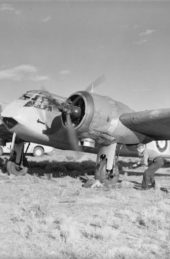“The Navy had always regarded the island as the keystone of victory in the Mediterranean…it should be held at all costs.” Admiral A.B. Cunningham, commander-in-chief Mediterranean Fleet during Operation Pedestal.
In the summer of 1942, a small island in the heart of the Mediterranean became the motivation for titanic battles in the sea and air. To the Allies, Malta was an essential Allied toehold in the central Mediterranean, hampering Axis efforts to support their forces in North Africa. Without Malta as a base for submarines and aircraft, Rommel’s Afrika Korps might overrun Egypt and capture the Suez Canal. Then, perhaps, the Middle East, India…To the Axis, however, Malta was a knife at the throat of its supply lines across the Mediterranean. Rommel was driving east, seemingly unstoppable, but he needed fuel, supplies.

HMS Eagle listing after it was struck by torpedoes.
This was the context in which the Royal Navy staged a series of critical attempts to resupply Malta in the summer of 1942. Operation ‘Pedestal’ was made up of 14 merchant ships, escorted by two battleships, three aircraft carriers, seven cruisers and 23 destroyers. The air support included two modern carriers, Indomitable and Victorious, and the veteran HMS Eagle, carrying around 100 aircraft – still only a third of the Axis air forces in the area. Furthermore, the majority of fighters were inferior to their German and Italian equivalents, and many of the pilots were inexperienced.
On 10 August, the convoy entered the Mediterranean. Any hopes the convoy had of remaining unnoticed were shattered when it passed under the flightpath of a Vichy French airliner. The following morning, enemy ‘snoopers’ appeared in the sky. The fighters did their best to tackle them before they could report the convoy’s position, but all secrecy was gone. The first contact was made when Sea Hurricanes caught a Junkers Ju88 and sent it diving away trailing smoke.
While eyes were turned upwards, a series of booms were heard throughout the convoy, and the aircraft carrier Eagle was seen wreathed in smoke and slowing – torpedoed by a U-boat. She sank with the loss of all but four of her Sea Hurricanes, depriving the convoy of a quarter of its air defence.

The Merchantman Waimarama explodes 13 August, 1942.
Yet the sternest test would be the following day, 12 August. Admiral Syfret, in charge of the escort, said “There were few moments when neither aircraft, submarines, torpedoes nor asdic contact were being reported.” The aerial attacks would comprise around 200 aircraft over the day, escorted by around 100 fighters. Facing them would be fewer than 50 Fleet Air Arm fighters remaining.
The attacks came in four main waves over the course of the day, with a variety of methods, conventional and unconventional. The former included high-level bombing, dive-bombing and torpedo attack by aircraft such as Junkers Ju88s, Savoia-Marchetti SM79s and Junkers Ju87 ‘Stukas’. The latter included an experimental circling torpedo, a radio-controlled bomber packed with explosives, and fighters fitted with bombs making a ‘sneak attack’ on HMS Victorious by following Sea Hurricanes into the landing pattern. These unorthodox attacks were unsuccessful, but the heavy bomb and torpedo attacks threatened to overwhelm.
The third wave, just after midday, was intended to completely saturate the convoy’s defences but the German and Italian air forces failed to co-ordinate adequately, and the attacks were spread out over an hour and a half. It gave the Fleet Air Arm just enough breathing space.

Indomitable on fire having been hit by Stuka dive bombers.
The first casualty among the merchant ships fell at 1318, when the Deucalion was hit and lost power. The attacks faded, giving the convoy some respite, but everyone knew more was coming.
The fourth attack developed at 1800. As the battle reached its height, Stukas plunged out of the sky towards the carrier HMS Indomitable while launched fighters. A bomb plunged through the bow and blew a huge hole in the ship’s side. The carrier was hidden by smoke and waterspouts, emerging listing but afloat. Fortunately, the attacks died away shortly afterwards. The enemy air forces had done their worst, and so far only one merchant ship had been damaged.
The carriers turned back at nightfall – by morning, the convoy was under the protection of fighters from Malta, but the worst was to come. A submarine torpedoed the tanker Ohio that evening and several merchantmen were sunk by torpedo boats overnight. Only five reached Malta, including the broken-backed Ohio, but with 30,000 tons of general cargo plus thousands of tons of vital fuel for ships and aircraft. Malta was viable as a strike base again, just as the battle in Egypt reached its crux point.
Matthew Willis is author of the Fortress of Malta trilogy, Harpoon, Bastion and Indomitable, published by Sharpe Books.









